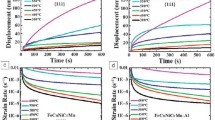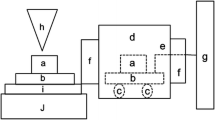Abstract
The current study investigates the thermally grown oxide layers (of the order of 5–10 μm thick) on Inconel 617 at elevated temperature of 950 °C in helium and air atmospheres using nanoindentation and nanoscratch techniques. Nanoindentation is also used to calculate the fracture toughness of the oxides using the crack initiation method. The oxide generated in helium tends to be more brittle with fracture toughness of 1.67 MPa.m1/2 whereas the oxide in air has a value of 2.18 MPa.m1/2. Hardness and elastic modulus extracted from nanoindentation are employed to calculate the adhesion and shear strength of the oxides using scratch technique. The oxide formed in helium exhibited higher adhesion strength compared to the oxide formed in air. The oxide in helium requires a higher load to break through the layer.
Graphical abstract











Similar content being viewed by others
Data availability
All data generated or analyzed during this study are included in this published article [and its supplementary information files].
References
C. Cabet, A. Terlain, P. Lett, L. Guétaz, J.M. Gentzbittel, High temperature corrosion of structural materials under gas-cooled reactor helium. Mater. Corros. 57, 147–153 (2006). https://doi.org/10.1002/maco.200503901
N.W. Richard, Kinetics of gas reactions and environmental degradation in NGNP helium (Idaho National Laboratory, Idaho Falls, 2006). https://doi.org/10.2172/911710
R.N. Wright, Summary of studies of aging and environmental effects on Inconel 617 and Haynes 230 (Idaho National Laboratory, Idaho Falls, 2006), p. 27. https://doi.org/10.2172/911722
K. Natesan, A. Purohit, S.W. Tam, Materials behavior in HTGR environments (Division of Engineering Technology, Office of Nuclear Regulatory Research, US Nuclear Regulatory Commission, 2003)
M.H. Hasan, Effects of mechanical and metallurgical variables on creep, fracture toughness and crack growth behavior of alloy 617 (Order No. 3391486) (2009). Available from ProQuest Dissertations & Theses Global (305066453). Retrieved from http://proxy.library.tamu.edu/login?url=https://www.proquest.com/dissertations-theses/effects-mechanical-metallurgical-variables-on/docview/305066453/se-2?accountid=7082
C. Jang, D. Lee, D. Kim, Oxidation behaviour of an alloy 617 in very high-temperature air and helium environments. Int. J. Press. Vessels Pip. 85, 368–377 (2008). https://doi.org/10.1016/j.ijpvp.2007.11.010
A. Chatterjee, A.A. Polycarpou, J.R. Abelson, P. Bellon, Nanoscratch study of hard HfB2 thin films using experimental and finite element techniques. Wear 268, 677–685 (2010). https://doi.org/10.1016/j.wear.2009.11.001
N.G. Chechenin, J. Bøttiger, J.P. Krog, Nanoindentation of amorphous aluminum oxide films I. The influence of the substrate on the plastic properties. Thin Solid Films 261, 219–227 (1995)
X. Li, D. Diao, B. Bhushan, Fracture mechanisms of thin amorphous carbon films in nanoindentation. Acta Mater. 45, 4453–4461 (1997). https://doi.org/10.1016/S1359-6454(97)00143-2
X. Li, B. Bhushan, Measurement of fracture toughness of ultra-thin amorphous carbon films. Thin Solid Films 315, 214–221 (1998). https://doi.org/10.1016/S0040-6090(97)00788-8
A. Mikowski, F. Carlos Serbena, C. Eugnio Foerster, A. Roberto Jurelo, C. Maurcio Lepienski, A method to measure fracture toughness using indentation in REBa 2Cu3O7- superconductor single crystals. J. Appl. Phys. (2011). https://doi.org/10.1063/1.3662121
B.R. Lawn, D.B. Marshall, Hardness, toughness, and brittleness: an indentation analysis. J. Am. Ceram. Soc. 62, 1–4 (1979)
M.S. Rahman, K. Polychronopoulou, A.A. Polycarpou, Tribochemistry of inconel 617 during sliding contact at 950 °C under helium environment for nuclear reactors. J. Nucl. Mater. 521, 21–30 (2019)
D. Kim, I. Sah, D. Kim, W. Ryu, C. Jang, High temperature oxidation behavior of alloy 617 and Haynes 230 in impurity-controlled helium environments. Oxid. Met. 75, 103–119 (2011). https://doi.org/10.1007/s11085-010-9223-5
D. Kim, C. Jang, W.S. Ryu, Oxidation characteristics and oxide layer evolution of alloy 617 and Haynes 230 at 900 °C and 1100 °C. Oxid. Met. 71, 271–293 (2009). https://doi.org/10.1007/s11085-009-9142-5
N. Tayebi, A.A. Polycarpou, Reducing the effects of adhesion and friction in microelectromechanical systems (MEMSs) through surface roughening: comparison between theory and experiments. J. Appl. Phys. (2018). https://doi.org/10.1063/1.2058178
S. Salari, M.S. Rahman, A.A. Polycarpou, A. Beheshti, Elevated temperature mechanical properties of Inconel 617 surface oxide using nanoindentation. Mater. Sci. Eng. A 788, 139539 (2020). https://doi.org/10.1016/j.msea.2020.139539
B.R. Lawn, A.G. Evans, A model for crack initiation in elastic/plastic indentation fields. J. Mater. Sci. 12, 2195–2199 (1977). https://doi.org/10.1007/BF00552240
W. Weibull, A statistical distribution function of wide applicability. J. Appl. Mech. 13, 293–297 (1951)
A. Mikowski, F.C. Serbena, C.E. Foerster, C.M. Lepienski, Statistical analysis of threshold load for radial crack nucleation by Vickers indentation in commercial soda-lime silica glass. J. Non Cryst. Solids (2006). https://doi.org/10.1016/j.jnoncrysol.2006.02.112
K.M. Lee, A.A. Polycarpou, Wear of conventional pearlitic and improved bainitic rail steels. Wear 259, 391–399 (2005). https://doi.org/10.1016/j.wear.2005.02.058
D. Tromans, J.A. Meech, Fracture toughness and surface energies of covalent minerals: theoretical estimates. Miner. Eng. 17, 1–15 (2004). https://doi.org/10.1016/j.mineng.2003.09.006
J. Päiväsaari, J. Niinistö, P. Myllymäki, C. Dezelah, C.H. Winter, M. Putkonen et al., Atomic layer deposition of rare earth oxides. Rare Earth Oxides Thin Films 111, 15–32 (2006). https://doi.org/10.1007/11499893_2
C. Ma, M. Liu, C. Chen, Y. Lin, Y. Li, J.S. Horwitz et al., The origin of local strain in highly epitaxial oxide thin films. Sci Rep 3, 3092 (2013). https://doi.org/10.1038/srep03092
T.I. Hysitron, 950 Triboindenter User Manual Revision 9.3. 0314 (2014), pp. 1–256
N. Tayebi, A.A. Polycarpou, F.C. Thomas, Effects of substrate on determination of hardness of thin films by nanoscratch and nanoindentation techniques. J. Mater. Res. 19, 1791–1802 (2004). https://doi.org/10.1557/JMR.2004.0233
N. Yu, A.A. Polycarpou, T.F. Conry, Tip-radius effect in finite element modeling of sub-50 nm shallow nanoindentation. Thin Solid Films 450, 295–303 (2004). https://doi.org/10.1016/j.tsf.2003.10.033
J.C. Hay, A. Bolshakov, G.M. Pharr, A critical examination of the fundamental relations used in the analysis of nanoindentation data. J. Mater. Res. 14, 2296–2305 (1999). https://doi.org/10.1557/JMR.1999.0306
M.S. Rahman, K. Polychronopoulou, A.A. Polycarpou, Tribochemical changes of alloy 800HT under sliding contact at elevated temperature in impure helium environment. Wear (2020). https://doi.org/10.1016/j.wear.2020.203508
W.C. Oliver, G.M. Pharr, An improved technique for determining hardness and elastic modulus using load and displacement sensing indentation experiments. J. Mater. Res. 7, 1564–1583 (1992)
S.R. Pergande, A.A. Polycarpou, T.F. Conry, Nanomechanical properties of aluminum 390–T6 rough surfaces undergoing tribological testing. J. Tribol. 126, 573–582 (2004). https://doi.org/10.1115/1.1698949
P. Benjamin, C. Weaver, Measurement of adhesion of thin films. Proc. R. Soc. Lond. A 254, 163–176 (1960). https://doi.org/10.1098/rspa.1960.0012
I.A. Ashcroft, B. Derby, Adhesion testing of glass-ceramic thick films on metal substrates. J. Mater. Sci. 28, 2989–2998 (1993). https://doi.org/10.1007/BF00354704
M.T. Laugier, Adhesion of TiC and TiN coatings prepared by chemical vapour deposition on WC-Co-based cemented carbides. J. Mater. Sci. 21, 2269–2272 (1986). https://doi.org/10.1007/BF01114266
M.T. Laugier, An energy approach to the adhesion of coatings using the scratch test. Thin Solid Films 117, 243–249 (1984). https://doi.org/10.1016/0040-6090(84)90354-7
P.J. Burnett, D.S. Rickerby, The scratch adhesion test: an elastic-plastic indentation analysis. Thin Solid Films 157, 233–254 (1988). https://doi.org/10.1016/0040-6090(88)90006-5
S.J. Bull, D.S. Rickerby, A. Matthews, A. Leyland, A.R. Pace, J. Valli, The use of scratch adhesion testing for the determination of interfacial adhesion: the importance of frictional drag. Surf. Coat. Technol. 36, 503–517 (1988). https://doi.org/10.1016/0257-8972(88)90178-8
H.E. Evans, Stress effects in high temperature oxidation of metals. Int. Mater. Rev. 40, 1–40 (1995). https://doi.org/10.1179/imr.1995.40.1.1
J.S. Wang, A.G. Evans, Measurement and analysis of buckling and buckle propagation in compressed oxide layers on superalloy substrates. Acta Mater. 46, 4993–5005 (1998). https://doi.org/10.1016/S1359-6454(98)00172-4
J.W. Hutchinson, M.D. Thouless, E.G. Liniger, Growth and configurational stability of circular, buckling-driven film delaminations. Acta Metall. Mater. 40, 295–308 (1992). https://doi.org/10.1016/0956-7151(92)90304-W
D.B. Marshall, A.G. Evans, Measurement of adherence of residually stressed thin films by indentation. I. Mechanics of interface delamination. J. Appl. Phys. 56, 2632–2638 (1984). https://doi.org/10.1063/1.333794
L.G. Rosenfeld, J.E. Ritter, T.J. Lardner, M.R. Lin, Use of the microindentation technique for determining interfacial fracture energy. J. Appl. Phys. 67, 3291–3296 (1990). https://doi.org/10.1063/1.345363
M.D. Thouless, An analysis of spalling in the microscratch test. Eng. Fract. Mech. 61, 75–81 (1998). https://doi.org/10.1016/S0013-7944(98)00049-6
F. Attar, T. Johannesson, Adhesion evaluation of thin ceramic coatings on tool steel using the scratch testing technique. Surf. Coat. Technol. 78, 87–102 (1996). https://doi.org/10.1016/0257-8972(94)02396-4
Acknowledgments
This study is supported by the U.S. Department of Energy (DOE) under NEUP Project 16-10732. The authors also would like to thank Dr. Richard Wright of INL, Dr. Sam Sham of ANL, and Dr. Yanli Wang of ORNL for providing samples and useful data as well as helpful discussions. Use of the Texas A&M Materials Characterization Facility is acknowledged. The author is also like to acknowledge the help of Dr. Anup K Bandyopadhyay of Materials Development and Characterization Center at Texas A&M University for acquiring the XRD spectra.
Author information
Authors and Affiliations
Corresponding author
Ethics declarations
Conflict of interest
On behalf of all authors, the corresponding author states that there is no conflict of interest.
Additional information
Disclaimer
Certain information on commercial equipment, material, manufacturers, and suppliers is included in this paper for clarity. This does not imply endorsement from anyone, nor the materials or equipment are the best available for this purpose.
Supplementary Information
Below is the link to the electronic supplementary material.
Rights and permissions
About this article
Cite this article
Rahman, M.S., Polycarpou, A.A. Nanomechanical and nanoscratch behavior of oxides formed on inconel 617 at 950 °C. Journal of Materials Research 37, 580–594 (2022). https://doi.org/10.1557/s43578-021-00438-5
Received:
Accepted:
Published:
Issue Date:
DOI: https://doi.org/10.1557/s43578-021-00438-5




